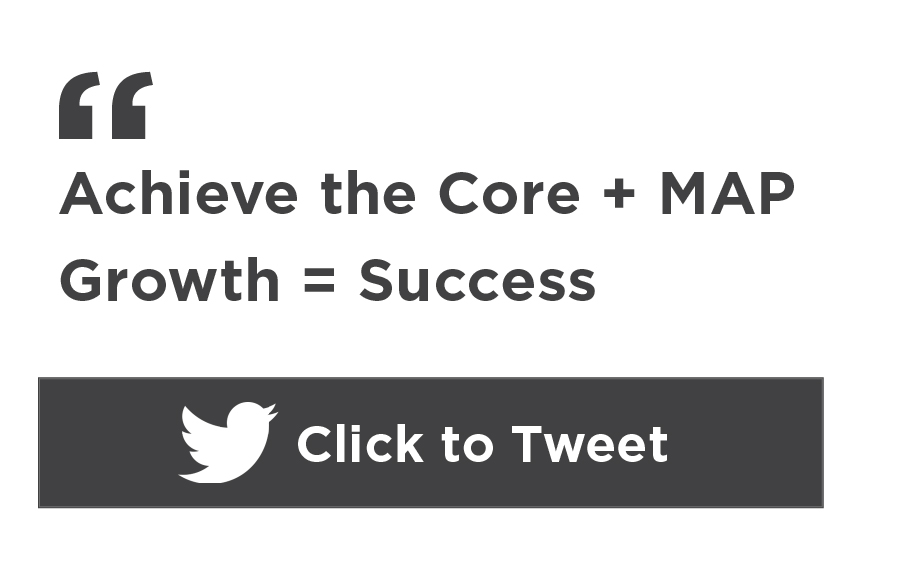If you’re a busy educator like I am, you might be thinking, “Oh, no! Two-thirds of the school year is over and I’m not two-thirds of the way through our math program! What am I going to do?” Fear not! There is still time to ensure that your students leave their current grade level with the major skills they need for next year.
In thinking about your program of study, can you pick out the key learning that each student should know and be able to do for your grade? Do you have confidence that the grade before yours will be doing the same? Are you too busy to figure all this out on your own? Achieve the Core and your MAP® Growth™ data can come to the rescue.
Achieve the Core + MAP Growth = Success
In my district, Achieve the Core and MAP Growth are helping us reach students and ensure math success during this difficult year. We are taking this last trimester of 2020–2021 to focus on the major clusters outlined in the documents from Achieve the Core on their page Mathematics: Focus by Grade Level. (If you haven’t seen them, I encourage you to take a look. They have saved us many hours of trying to figure out where we should place our efforts with the time we have left this school year.)
Each document lets educators see where the major work of the grade level is and, by identifying that, schools can unify their focus for these last few months to help build a strong foundation of content knowledge that students will need for the next level of learning in the 2021–2022 school year. If you’re a MAP Growth partner and tested this year, your winter and spring RIT scores can help you see exactly where your students are and also help you differentiate instruction.
(A note to administrators: It’s never too soon to start thinking about next year. I’m planning on having our teams begin 2021–2022 with a focus on the major clusters from the previous school year during September. We will then transition to our current grade-level documents and the Achieve the Core focus areas. I encourage you to consider a similar practice so there can be a clear bridge between the school years and both teachers and students can be set up for success.)
Advice in action
To see how all of this comes together, let’s take a sixth-grade example. On the Achieve the Core grade 6 math focus document, you’ll see that the Standard 6.RP.A is part of the major work.
You want to ensure that your students leave grade 6 with a strong understanding and solid skills for this standard. To do this using MAP Growth data, you can head over to the Learning Continuum test view area on the MAP Growth site. Use the “Edit Display Options” tool bar to sort the statements by standard and your grade level. Here’s what you would see for your 191–220 RIT sixth-graders. Note that the goals outlined below are where you need to start and not what they’ve already learned. You can identify which students are in these RIT bands by looking at your Class Breakdown Report for real and complex number systems (that is where the ratio work falls).
Ready, set, differentiate
Achieve the Core and MAP Growth used in tandem will get you pretty far. Next comes the truly amazing part: making the learning come to life through your teacher craft, knowledge of your learners, and ability to put targeted, trusted resources into place and spark learning. Here are some tools to help you with that:
- Khan Academy. With MAP® Accelerator™, developed in partnership with Khan Academy, you can get instant access to personalized learning pathways for your students that are based on their MAP Growth scores. If your school isn’t using MAP Accelerator yet, Khan Academy Mappers will help walk you through the process for entering MAP Growth scores for your students. And if you’re not a MAP Growth user at all, Khan Academy can still connect you to standards-aligned math content.
- Teacher Advisor. IBM’s Teacher Advisor quickly connects teachers to more than 10,000 free math resources, including lessons and videos, from places like Open Up Resources. Use it without MAP Growth scores, or enter them in to get tailored recommendations. Read “Support on-grade learning in math with IBM’s Teacher Advisor and MAP Growth” to learn more.
- Curriculum Works and more. Just like Khan Academy and Teacher Advisor, Curriculum Works will let you enter MAP Growth data and support your differentiation efforts. You can learn about additional instructional math partners in our blog post “>11 resources to support unfinished math learning.”
You’re almost there
When we all focus on the same goals, we can grow faster and stronger for the benefit of our learners. Keep up the amazing work you are doing, and know that you just have to reach out and grab the finish line. Your work in helping students build the strong foundation they need will ensure they gain the skills and knowledge to be successful in mathematics. You’ve got this!











